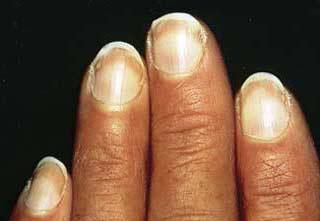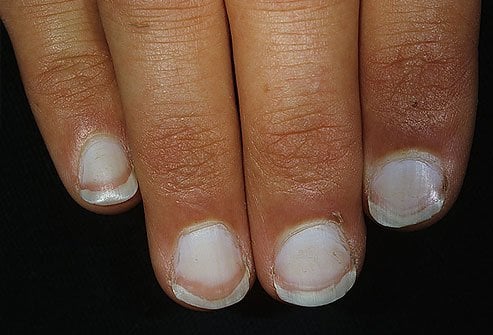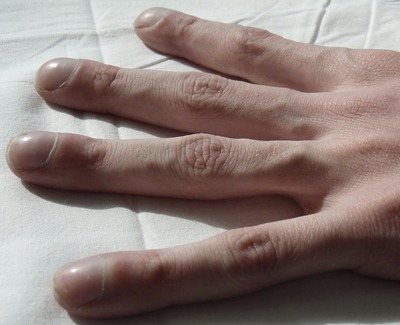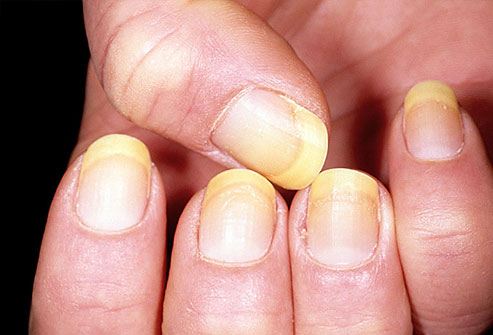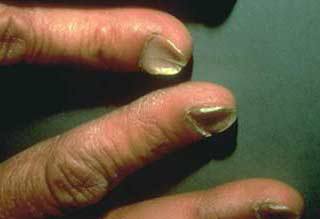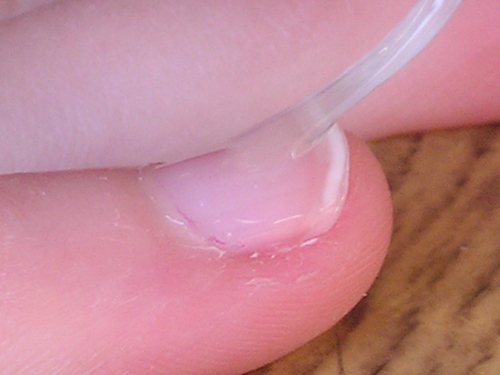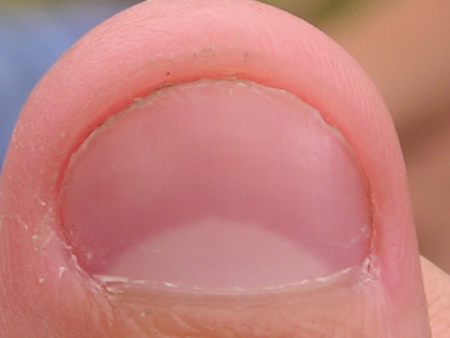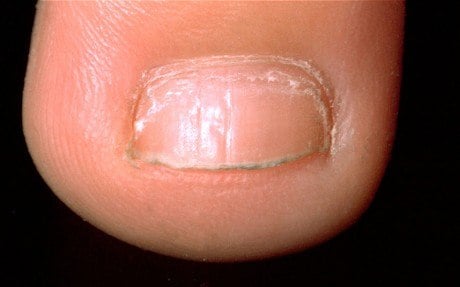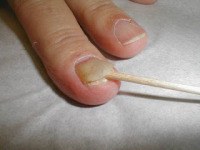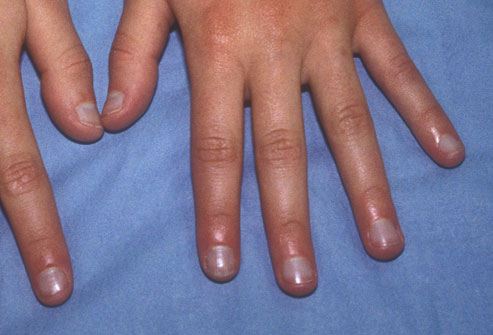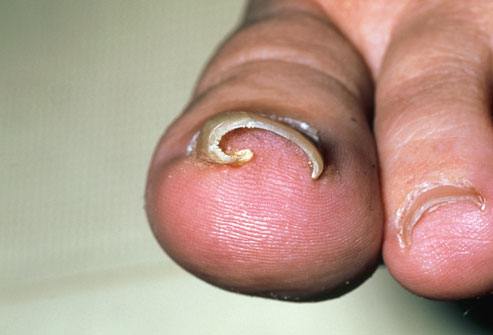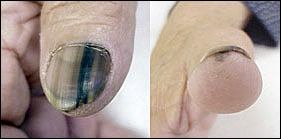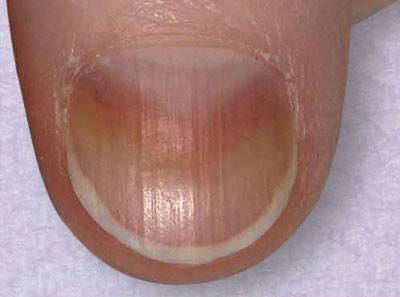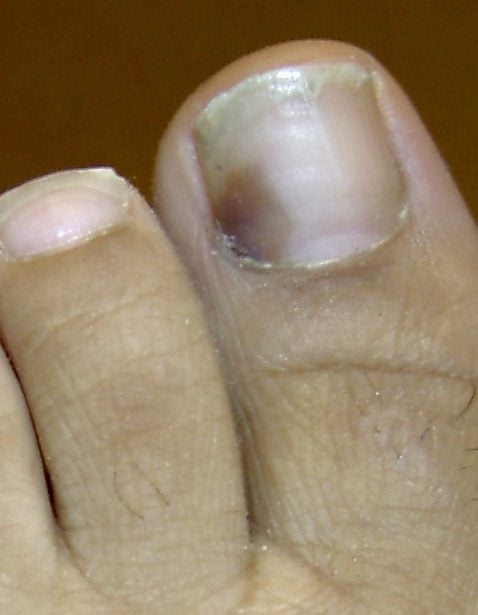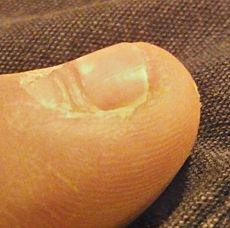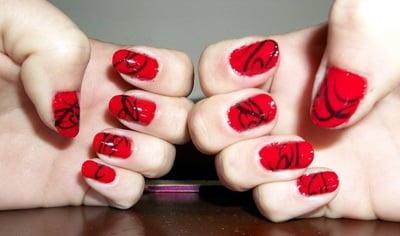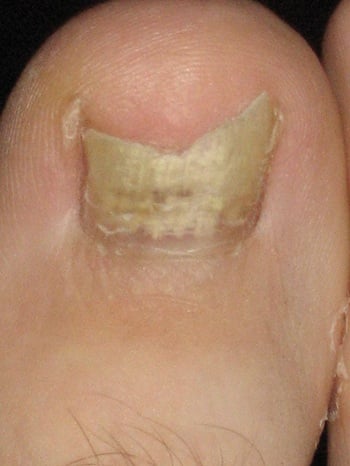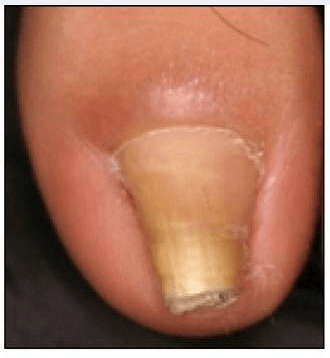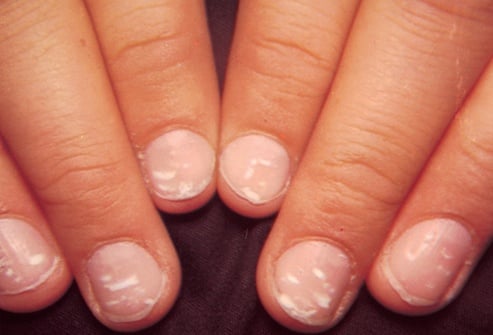1. Dark Bands on Nail Tips: Possibly Diabetes or Another Ailment
If the tips of your nails display dark bands on each one, it might simply be a sign of getting older. However, according to the above photo and information from the Mayo Clinic, it could also be “Terry’s nails,” liver disease, congestive heart failure or diabetes. If it is a diagnosis of diabetes, experts say you should have a podiatrist cut your toenails as well as teach you how to do so yourself to prevent harm.
2. White Nails: Liver Problem
If your nails are white like in the above photo from WebMD, the website cautions that it could be a sign of hepatitis or another liver problem.
3. Clubbed Nails: Lung Problems
According to the National Center for Biotechnology Information, “clubbed” or rounded nails could point to lung problems.
4. Yellow Nails: An Infection or More Serious Disease
WebMD also warns that yellow nails could be the sign of a fungal infection – or something much more serious, like thyroid or lung disease.
5. Spoon Nails: Anemia, Liver or Heart Problems
Nails that are curved upward and soft to the touch are called “spoon nails” and could point to anemia, liver ailments, heart disease or hypothyroidism, reports the Mayo Clinic.
6. Weak Nails: Too Many Acrylic Manicures
If your nails chip and split quite a bit or feel weak overall, Prevention states that it’s probably time to give them a chance to breathe and take a break from any constant acrylic nail wearing or hard-hitting manicure styles.
7. Bitten Nails: Anxiety
WebMD calls nail-biting a stress-related condition, something you might engage in when you’re bored, anxious or nervous. Polishing your nails or using bad-tasting products like Mavala Stop can help break the harmful habit.
8. Nail Dents: Skin Disorders, Arthritis or Alopecia
According to the NHS, dents in the nails may mean you also suffer from conditions like psoriasis, eczema or even unexpected ailments such as reactive arthritis or alopecia areata, which involves hair loss.
9. Loose Nails: Hyperthyroidism or Too-Tight Shoes
Nails that tend to come away from the nail bed could be an indication of hyperthyroidism, says Cedars-Sinai. Runners and athletes might discover their toenails fall off over time if they wear improper fitting shoes.
10. Blue Nails: A Lack of Oxygen
There’s a reason physicians ask patients to remove their nail polish prior to being put under anesthesia during surgery: They want to make sure your nails don’t turn a bluish color, which can be a sign of not getting enough oxygen or other lung problems, says WebMD.
11. Ingrown Toenails: Bad Shoes, Grooming or Injury
Credit: Dr. P. Marazzi / Photo Researchers, Inc If your toenails tend to grow and curl into your skin, you might be one of those folks who have thick nails. WebMD also cautions that your nail-cutting habits might be the source of the problem, along with shoes that don’t fit properly or some type of injury to the foot.
12. Dark Nails: Might Be Melanoma
According to American Family Physician, although dark stripes in nails can be common to certain darker-skinned people, if they show up in conjunction with a discoloring of the skin beneath, it means that a biopsy should be undergone to make sure it’s not melanoma.
13. Nail Ridges: No Worries
Vertical ridges in your nails might look a little worrisome, but experts like the Mayo Clinic say they are common and nothing to worry about. Pundits claim they sometimes simply come with age.
14. Blood Under the Nail: Injury
Chances are if you see a darker spot under your nail, representing a pool of blood, you know how you got the injury. Maybe you hit your thumb with a hammer and the wound is painful to the touch. The American Osteopathic College of Dermatology says that treatment can include icing and elevation.
15. Horizontal Lines: Zinc Deficiency, Diabetes or Other Diseases
While vertical lines are harmless, horizontal lines across the nails might not be. Called “Beau’s lines,” these types of ridges or indentations could mean there has been some type of sickness that has caused elevated fevers, or they are due to diabetes or zinc deficiencies, says the Mayo Clinic.
16. Thin Nails: Gel Nails, UV Light and Chemical Removal Reactions
The so-called “gel nails” may look great and are beloved because of how shiny and long-lasting the manicures can be, however, the American Academy of Dermatology cautions that the process of using UV lights and other chemicals during the procedure can cause thin nails.
17. Cracked and Missing Nails: Fungal Infection
If any parts of your nails resemble the discolored, cracked and partially missing toenail in the photo above, the U.S. National Library of Medicine National Institutes of Health reports that this is a condition called onychomycosis, a fungal infection.
18. Pincer Nails: Hereditary, Bad Shoes or Too Much Trimming
Pincer nails can appear as curved nails with many varying formats. They can be due to too much trimming – or, as the Annals of Dermatology reports, pincer nails might be hereditary, caused by bad-fitting shoes or tumors.
19. White Spot on Nails: Trauma or Harsh Manicures
Though children may joke that white spots on your nails represent the number of boyfriends or girlfriends you have, in actuality, WebMD says they are due to heredity, an injury, hard manicures or some other unknown cause.
20. Painful Nails: Any of the Above
Maybe it’s not a matter of just how your nails look, but how they feel – and if that feeling is pain, it could be due to any of the above-described issues or something else. Thin or weak nails can be painful because there are fewer layers atop the nail that may have been stripped by harsh treatments. Therefore, it’s best to pay a visit to your doctor if you’ve encountered any of these nail issues and help restore yourself to optimal nail health. Featured photo credit: Woman_Fingers_1686 (1).JPG by Alvimann via mrg.bz
